If you’ve heard about deadly all-white amanitas, you may be familiar with destroying angel mushrooms. What some folks don’t know, however, is that the common name “destroying angels” actually refers to similar toxic species within the Amanita genus.
In this guide, we’ll cover the species of amanitas known as destroying angels. We will discuss their shared characteristics, how to identify them, where they grow, and what makes them so toxic.
So, without further ado, let’s jump in!
Destroying Angel Mushrooms: Fungi Classification
Now, while the common name destroying angels refers to a handful of species, they all belong to the Amanita genus. This genus is famous for containing some heavy-hitter deadly mushrooms. The four most commonly documented species known as destroying angels are Amanita bisporigera, Amanita ocreata, Amanita virosa, and Amanita verna. For separate destroying angel species that share an overlapping growing region, misidentification is common.
After covering their common traits, we’ll discuss in further detail each of these related, similar-appearing species. We will also look at the morphological characteristics that distinguish them.
Common Characteristics of Destroying Angels
Alright, we’re going to dive into some of the overlapping macro and microscopic characteristics of destroying angels that these four species share.
5 Common Characteristics
Firstly, all four species share a stark white coloring of the fruiting body, which includes the flesh, cap, gills, stipe, partial veil, and volva. While some other mushrooms are off-white or cream-colored, destroying angels have a particularly vivid, eye-catching white coloring.
Secondly, as members of the Amanita genus, all-destroying angels feature a partial veil and a universal veil. This means that the immature fruiting body is completely encased by an egg-like membrane that protects it while it matures. As the mushroom grows, the cap tears away from the universal veil, with a sac-like base remaining around the bottom of the stipe known as a volva. The partial veil covers the gills, which are the spore-producing tissue of amanitas. As the cap grows and expands outward, it tears away from the partial veil, revealing the gills and leaving a ring of thin membranous tissue around the upper portion of the stipe(stem).
Thirdly, The gills of all destroying angels are free or nearly free, meaning there is a thin ring of space between the gills and the top of the stipe where it connects to the cap. In comparison, attached gills are connected to the stipe, with some species featuring gills running down the stipe (decurrent and subdecurrent)
Fourthly, all-destroying angels feature a similar fruiting body structure with long, slender stipes that taper toward the cap and caps that expand outward as they mature into almost flat discs.
Finally, all species of destroying angels are mycorrhizal, meaning they derive their nutrients from forming symbiotic fungi-plant (in their cases, trees) relationships. This means you’ll always find destroying angels growing from the soil where their underground mycelium is connected to the roots of trees.
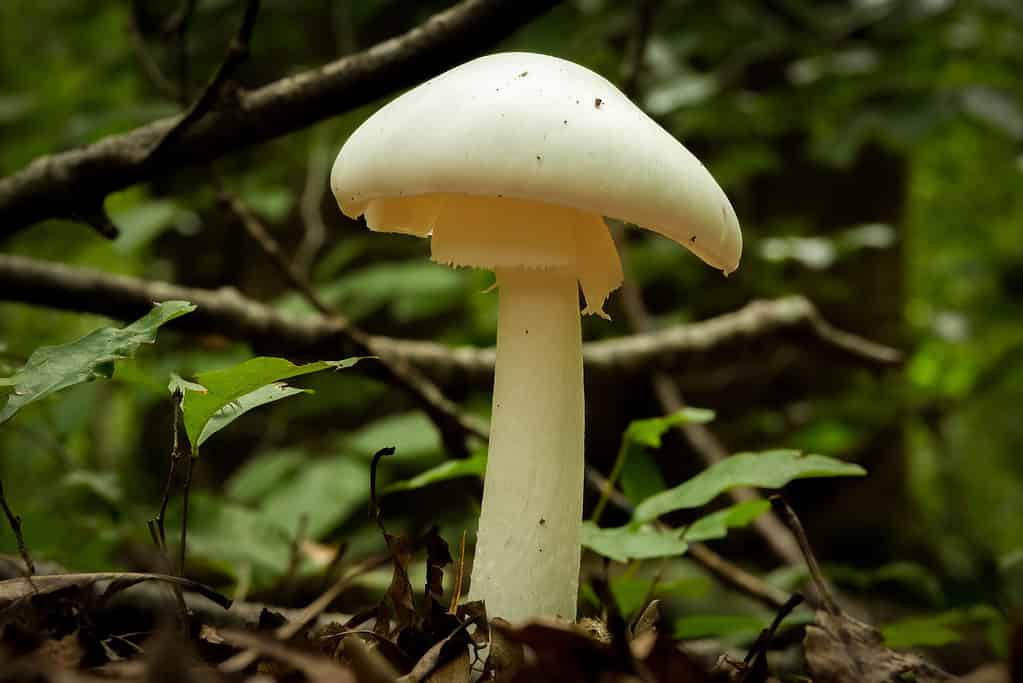
A majestic but deadly destroying angel.
©samray/Shutterstock.com
Amanita bisporigera
In Eastern North America, the destroying angel you’re most likely to encounter is Amanita bisporigera, also known as the eastern destroying angel and the eastern North American destroying angel.
Eastern destroying angels are typically mycorrhizal with oak trees, so you’ll often find them in these forests. They may also form symbiotic relationships with other hardwood species, but they have a strong affinity for oak species.
The cap of A. bisporigera can reach 4 inches across at maturity. As an immature fruiting body, the cap will appear oval, becoming more convex to flat as it grows. The cap color is vividly white, and the very center of the cap may slightly discolor to off-white when aged.
The gills are crowded, white, and free to nearly free from the stipe. The spore print is white.
On this species, the stem can reach up to 5.5 inches long, about .75 inches thick, and can be a bit shaggy from remnants of the veil, or it can be smooth. The stem contains a partial veil ring around the upper portion and the sac-like volva enclosing the base.
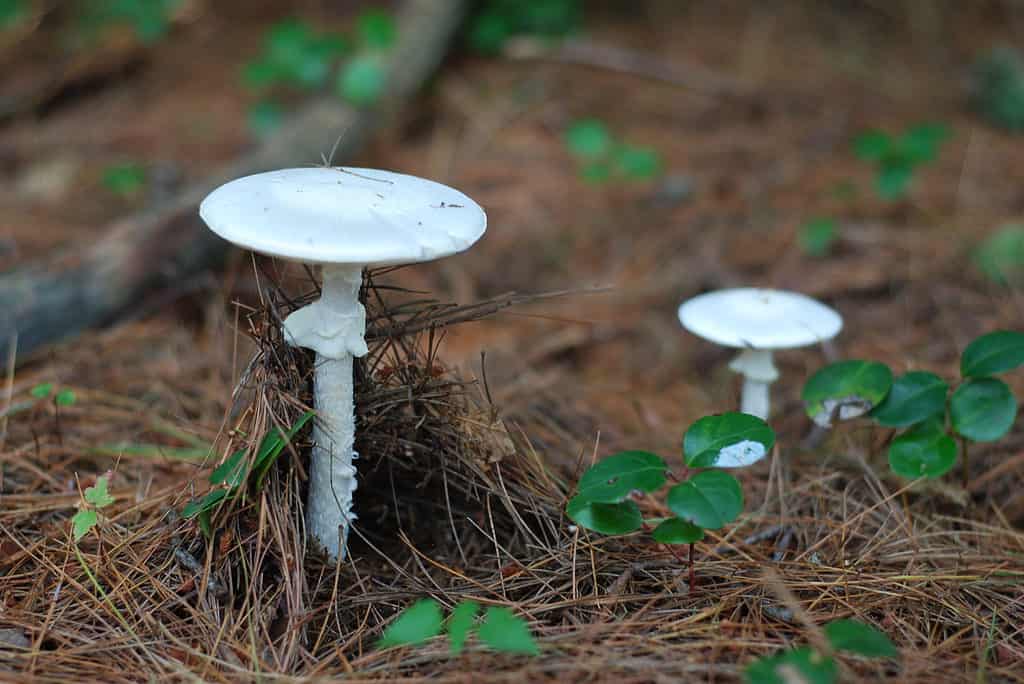
The cap of
Amanita bisporigeracan reach 4 inches across at maturity.
©Jarek Tuszyński / CC-BY-SA-3.0, CC BY-SA 3.0 <https://creativecommons.org/licenses/by-sa/3.0>, via Wikimedia Commons – License
Amanita ocreata
So, our next destroying angel is Amanita ocreata, also known as the western destroying angel or the Western North American destroying angel. The western destroying angel can be found distributed across temperate hardwood forests of California and the Pacific Northwest. Like other destroying angels, it typically forms mycorrhizal relationships with oak trees.
The cap of the western destroying angel can reach up to 5 inches across. The cap is hemispherical when immature and becomes more convex to disc-like as it matures. Aged specimens can have a bit of pale ochre-yellowish coloring in the center of the cap.
The gills are moderately crowded to crowded, free to nearly freely attached to the stipe, and the spore print is white.
On A. ocreata, the stipe can grow up to 6 inches tall and about 1.25 inches thick. Mature specimens have a partial veil remnant ring around the upper portion of the stipe and a remnant of the universal veil encased around the base.
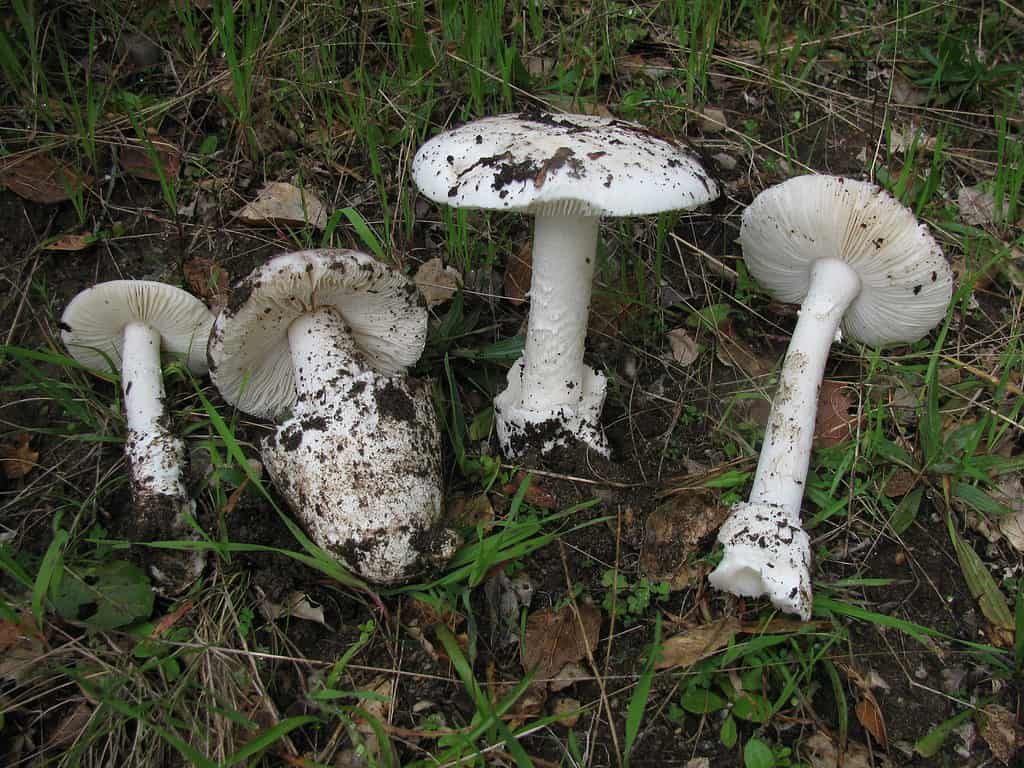
caps can reach 5 inches across, and their stipes can grow up to 6 inches tall and about 1.25 inches thick.
©This image was created by user Ryane Snow (snowman) at Mushroom Observer, a source for mycological images.You can contact this user here.English | español | français | italiano | македонски | മലയാളം | português | +/−, CC BY-SA 3.0 <https://creativecommons.org/licenses/by-sa/3.0>, via Wikimedia Commons – License
Amanita virosa
Next on our list of destroying angels is Amanita virosa, commonly known as the European destroying angel. This species and our next European destroying angel, Amanita verna, are often referred to each other interchangeably, but they are indeed separate species. We’ll talk more about distinguishing the two.
Amanita virosa, like other destroying angels, features all-white gills, flesh, cap, and stipe when young, but this species is known to discolor a bit more than other destroying angels when it ages. An aged, mature A. virosa can frequently have yellowish, tan, or cream-colored discoloration in the center of the cap. Its flesh, however, remains pure white inside and unchanging when bruised.
The stipe of A. virosa can reach up to 6.5 inches tall and about .5 inches wide, making the stipe of this species notably narrow and tall compared to its counterparts. Additionally, the stipe is distinctly shaggy below the partial veil ring. The stipe contains a partial veil ring and remnants of the volva at the base.
A. virosa is typically found near oak trees in hardwood or mixed-hardwood forests across temperate regions of Europe.
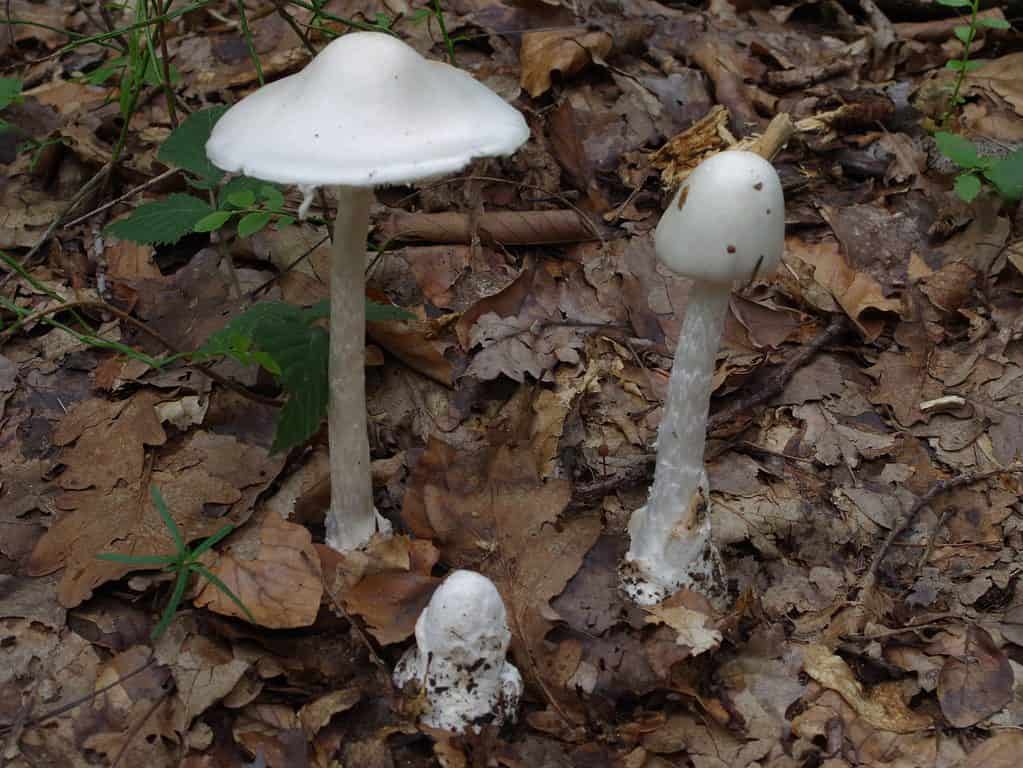
is more narrow and taller compared to other destroying angel mushrooms and has a shaggy stipe.
©Jerzy Opioła, CC BY-SA 4.0 <https://creativecommons.org/licenses/by-sa/4.0>, via Wikimedia Commons – License
Amanita verna
The final destroying angel species on our list is Amanita verna, also known as the Spring destroying angel and the fool’s mushroom. Like A. virosa, this mycorrhizal European species is also usually found in temperate hardwood or mixed-hardwood forests and normally near oak trees.
The cap of Amanita verna is a bit smaller than its counterparts, typically maxing out at 4 inches wide. It shares similar cap morphology as other destroying angels. Immature fruiting bodies have hemispheric caps that expand into convex and then flattened disc-like shapes as they mature. This species tends to discolor a bit of pale tan on the center of the cap when aged.
The gills are close and short but not as crowded as those of their counterparts. The spore print is white.
The stipe, also rather shorter than other destroying angels, tend to reach only 4 inches tall. It is rather shaggy below the partial veil ring at the upper portion of the stipe. Along with its relatives, mature A. verna specimens contain a partial veil ring and volva at the base.
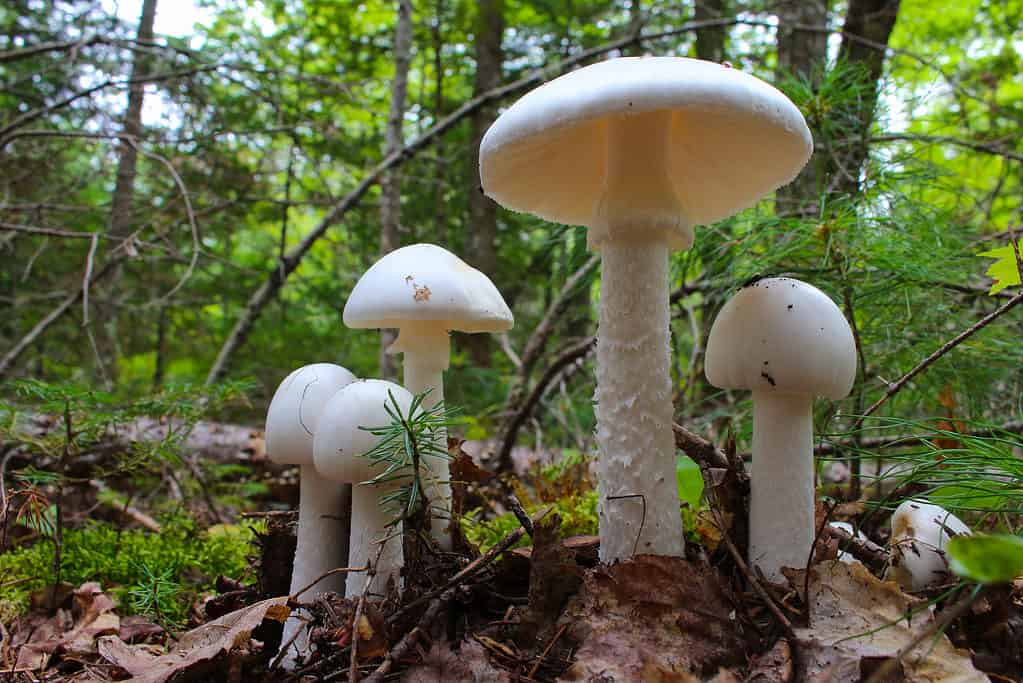
This Amanita is one of the most toxic mushrooms in the world.
©gvictoria/Shutterstock.com
Destroying Angel Mushrooms: What Makes Them So Toxic?
The toxins in destroying angel mushrooms are so poisonous that they are responsible for about 95% of all mushroom-related deaths. Not all amanita mushrooms contain amatoxin; indeed, only a small percentage of amanitas are deadly to humans, but all destroying angel species contain this toxin. Amatoxin is a hepatotoxin, meaning it is a chemical compound that causes injury to the liver.
When poisoned by a destroying angel, if the patient does not receive timely and acute intervention, they risk liver failure, coma, and death. The timeline of poisoning is pretty much the same across destroying angel mushrooms. Amatoxin poisoning in humans presents in three stages.
Three Stages of Destroying Angel Mushroom Poisoning
First, people experience intense gastrointestinal upset. Typically, the poisoning victim won’t start experiencing symptoms until six to 12 hours after ingestion. Signs and symptoms usually include vomiting, nausea, profuse watery diarrhea, abdominal pain and cramping, and dehydration.
This phase usually wraps up after the 24-hour mark, in which symptoms often disappear for a day or two, leading many poisoning victims to believe they have recovered. However, liver damage intensifies during this second phase, characterized by a lack of symptoms. It is normally after the 24-hour mark that signs of liver damage will show up on blood work.
During the third phase, signs of both acute liver and kidney damage or failure are often present. At this point, some patients need a liver transplant to survive. It is in this final stage that patients may die, typically between the 3rd-7th day post-ingestion.
Treatment can involve intensive IV support, liver transplant, or an infusion of silibinin, a compound derived from the milk thistle plant that can inhibit the uptake of amatoxin by the liver.
The photo featured at the top of this post is © iStock.com/dabjola
The information presented on or through the Website is made available solely for general informational purposes. We do not warrant the accuracy, completeness, or usefulness of this information. Any reliance you place on such information is strictly at your own risk. We disclaim all liability and responsibility arising from any reliance placed on such materials by you or any other visitor to the Website, or by anyone who may be informed of any of its contents. None of the statements or claims on the Website should be taken as medical advice, health advice, or as confirmation that a plant, fungus, or other item is safe for consumption or will provide any health benefits. Anyone considering the health benefits of particular plant, fungus, or other item should first consult with a doctor or other medical professional. The statements made within this Website have not been evaluated by the Food and Drug Administration. These statements are not intended to diagnose, treat, cure or prevent any disease.
Sources
- Amanitaceae.org, Available here: http://www.amanitaceae.org/?Amanita+bisporigera
- Amanitaceae.org, Available here: http://www.amanitaceae.org/?Amanita+ocreata
- Amanitaceae.org, Available here: http://www.amanitaceae.org/?Amanita+virosa
- Amanitaceae.org, Available here: http://www.amanitaceae.org/?Amanita+verna
- Horowitz BZ, Moss MJ. Amatoxin Mushroom Toxicity. [Updated 2022 Jun 28]. In: StatPearls [Internet]. Treasure Island (FL): StatPearls Publishing; 2022 Jan, Available here: https://www.ncbi.nlm.nih.gov/books/NBK431052/
Thank you for reading! Have some feedback for us? Contact the AZ Animals editorial team.






